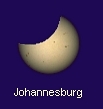|
- - text and links as of last publication - - April 19th, 2004 Sun Partial Eclipse
2004 two solar eclipses are only partial ones. First is taking place in southern hemisphere from southern Africa to Antarctica. A partial eclipse occurs when Moon's penumbra only reaches Earth as umbra hits nowhere. Eclipses occur when Sun, Moon and Earth are in line. Moon is projecting on Earth two zones of shadow: the "umbra" ("shadow" in Latin) which is a dark shadow, and the "penumbra", which is a lighter outer shadow. If umbra and penumbra both hit Earth a complete eclipse occurs: Sun is seen completely occulted for places along eclipse's path. If umbra misses Earth and penumbra reaches it, a partial eclipse only occurs: Sun is partially occulted by Moon, displaying diverse aspects of a Sun's crescent along eclipse's process. Eclipse is beginning at 11:29:56 UT (P1) and ending at 15:38:36 UT (P2). Greatest eclipse is at 13:34:01 UT. Practically, for southern Africa dwellers, eclipse is taking place in the afternoon as for easternmost places sunset puts an end to the phenomenon. Theoretically the eclipse is important as at the greatest eclipse 73 per cent of the solar disk is masked (eclipse magnitude 0.73541). For how an eclipse works and how to observe one, see the tutorials "Sun Eclipses" and "Observing a Sun Eclipse". Remember that observing an eclipse is as dangerous as usually observing the Sun. In the second tutorial, you will find advices about these dangers! Observation Reports: this first eclipse of the year did unluckily yield about no feedback
Website Manager: G. Guichard, site 'Amateur Astronomy,' http://stars5.netfirms.com. Page Editor: G. Guichard. last edited: 12/28/2010. contact us at ggwebsites@outlook.com |
 For observers in Africa however, Moon won't occult Sun as much. See how Sun will look at greatest eclipse in Johannesburg (South Africa). For more details (map of visibility, times for diverse locations) see Fred Espenak's
For observers in Africa however, Moon won't occult Sun as much. See how Sun will look at greatest eclipse in Johannesburg (South Africa). For more details (map of visibility, times for diverse locations) see Fred Espenak's 